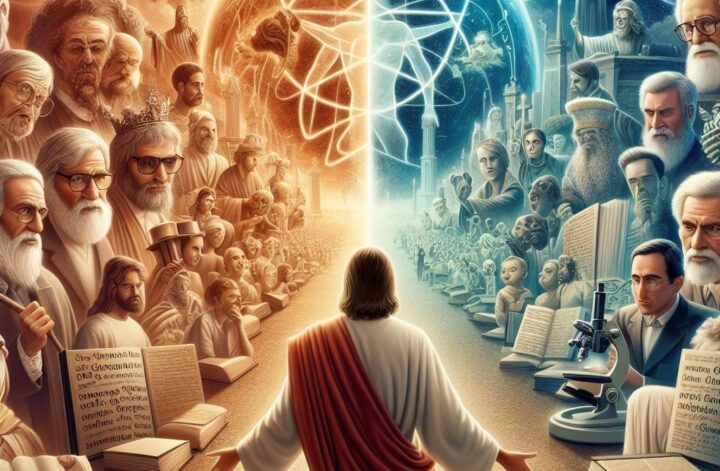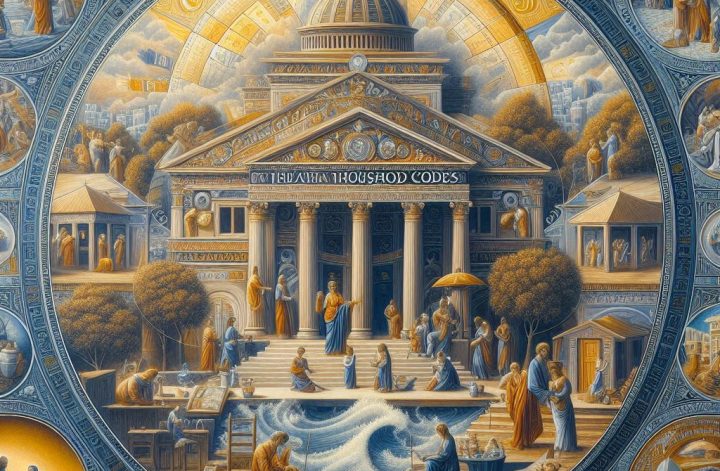Clearly defining terms
Anyone who carefully reads the book of Genesis can quickly tell that the first eleven chapters are markedly different from the rest. Indeed, readers have noticed this feature for millennia. Genesis 12 describes the call of Abraham and the rest of the book chronicles events in the lives of Abraham’s posterity. Genesis 1-11, however, is quite different. The scope of these parts of Genesis is cosmic and global. Genesis 1-3 describes the creation of the cosmos, earth, and humans. William Craig argues that when read in light of the whole of Genesis, the Pentateuch—of which Genesis is only one part—and the ancient Near East (ANE) contexts, Genesis 1 to 11 is best understood as a myth with a keen interest in history. Genesis 1-11 functions to situate the nation of Israel within the cosmos. As Craig writes, it “is a sacred preamble to the history of Israel” (54).
Craig’s use of “myth” here is technical. The word here does not mean “falsehood” or an untruth. Instead, the folklorist sense is meant. Based on folklore scholarship, Craig characterizes a myth as a narrative, literary or oral, “handed down from generation to generation” that aims “to anchor present realities such as the world, mankind, natural phenomena, cultural practices, and the prevailing cult in a primordial timeline” (45). Furthermore, myths are generally narratives about gods and “are sacred for the society that embraces them” (45). A key feature of myths that will be especially relevant for us is that they “exhibit fantastic elements and are not troubled by logical contradiction or incoherence” (46). By “fantastic elements,” Craig means elements which, if literally interpreted, will make the mythological story demonstrably false.
It is probably worthwhile to emphasize a few points at this juncture. First, the hermeneutical proposal that Genesis 1-11 is best read as mytho-history is only one viable approach to the text. The unconvinced Christian may reject the idea and choose another she wants, provided the approach adequately engages with the text. Second, this conclusion is not motivated by a need to deny miracles. Dr. Craig is a Christian apologist and philosopher who continues to defend the occurrence of miracles.
On the contrary, the conclusion is motivated by the text of Genesis 1-11. As we shall soon see, the author(s) of Genesis 1-11 does not say at any point that the events described are miracles like, say, the Gospels do. The assumption that Genesis 1-11 describes miraculous events is simply that—an interpretive assumption. Lastly, the conclusion that Genesis 1-11 is mytho-history is not an arrogant reading by a modern man who thinks he is better than his grandparents. On the contrary, Craig argues that the authors of Genesis 1-11 intended it as a mytho-history. Considering the level of intelligent redaction and style in Genesis, Craig further argues that there are even fantastic elements in the work that the authors could not have missed. We shall survey some of these elements next.
Reading the text in its own context
Genesis 1 opens with a description of God as a transcendental being; he existed before the cosmos. However, Genesis 2 proceeds to describe God as a humanoid being forming Adam from dirt and breathing—through his mouth, we may imagine—into the lifeless man’s nostrils so that he became a living being. Understood literally, these ideas are incompatible. A transcendental being cannot also be humanoid. Now, I know that your churched mind is probably going, “well, the humanoid appearance is a theophany, a case of God appearing as a man.” To be sure, Genesis and the rest of the Bible are rich in theophanic accounts. But this is not the case in Genesis 1 to 11. For instance, in the human creation account, the text does not present God’s appearance as a theophany as does texts like Genesis 18: 1-2 or the Angel of the Lord passages. Besides, even when there was no human to witness God’s presence, the text still describes God anthropomorphically. Adam does not yet exist as a living being capable of noticing God’s presence when God breathed into his nostrils. And when God created Eve, Adam was unconscious. Yet, the text still describes God in a humanoid form.
We also have anthropomorphic descriptions in Genesis 3 where God strolled in Eden in search of Adam and Eve, as well as in the flood story in Genesis 6-9, where the text says that God regrets having made humans in a manner consistent with a shortsighted engineer’s displeasure with her malfunctioning design. Genesis 8:21 even describes God as being so pleased with the smell of Noah’s burnt offering that he vowed never again to destroy living creatures because of malfunctioning humans. All these ideas are unfitting for a transcendental being that the author of Genesis presented in chapter 1. Craig comments (102), “Such incoherence could not possibly have escaped the notice of the pentateuchal author, for it is so patent, and yet he felt no need to expunge the anthropomorphic elements. He doubtless assumed that his readers would have understood such anthropomorphic descriptions of God to be just part of the storyteller’s art, not serious theology.” In other words, the author intends his work to be taken as mythic in character.
There also are narrative inconsistencies in Genesis 1 -11. We discussed the issue of the origin of Cain’s wife earlier. Undoubtedly, the author must know that there was only one family on earth within his narrative world. Yet, he saw no need to clean this up. Also, the problematic claim in Genesis 4:26 that “men began to call upon the name of Yahweh” is incompatible with the author’s statement in Exodus 6:3 that the name “Yahweh” had not yet been revealed to men. Craig reminds us, “The point is not whether these apparent inconsistencies are somehow resolvable but that the author is just untroubled by them” (104).
Besides, Genesis 1-11 has several fantastic elements which, when understood literally, will be false. Consider the trees which play very critical roles in Genesis 2-3. Are we really to think that there was a literal tree in Eden which, when someone eats its fruit, the eater receives knowledge of good and evil? This reading is very much unlikely to be the author’s intent for several reasons. First, if humans gain any knowledge from eating, it would be knowledge of the thing eaten. Are we to think that the tree’s fruits are literal “knowledge of good and evil”? Recall that there is nothing in the text suggesting that the author conveys miraculous events. In any case, the assumption of miracle is also quite problematic. It would mean that as someone reached out to eat the fruit of the tree, God would grant the eater knowledge of good and evil—thereby making God the author of evil. We may say something similar about the tree of life. It is implausible that Eden had a literal tree whose fruit granted immortality to eaters. (Once again, recall that the text does not say God does a miracle here.)
What about the reasoning snake? Undoubtedly, the author of Genesis was familiar with local wildlife. Indeed, the author introduces the snake thus: “Now the snake was more crafty than any of the wild animals the LORD God had made” (Genesis 3:1). So, the snake was just one of many wild animals in Eden. Nothing here suggests that the snake is possessed or is someone else presenting as a reptile. Yet, the author describes the snake as talking to the woman. Are we to believe that snakes (and all wild animals?) spoke in the past, endowed with rationality? Once again, this reading is quite unlikely.
A reader may be thinking, “well, that serpent was the Devil in a reptilian form.” This reading is problematic for a few reasons. First, as already mentioned, the text does not say anything of this sort. Second, the idea of a devil being a specific divine enemy of the people of God was not yet (fully) developed at the time of the Pentateuch. (Even the adversary character in the book of Job is not the Christian “Devil.”) Most importantly, it is a wrong exegetical move to use a later work by a different author to interpret an earlier work. It may be okay to jump around scriptures for a sermon. It is never sound to do so in the business of interpreting a text. We seek to understand Genesis on its author’s terms, and on those terms, the snake is merely a wild animal. If that is correct, it is unlikely that the author meant his description of the snake to be taken literally.
There are several other plausibly fantastic elements in Genesis to which we may point. We could enquire, for instance, if God literally performed surgery on Adam when forming Eve or even the creation of Adam himself from dirt. What about the apparent claim that the whole universe was less than 2,000 years old by the time of Abraham? Given the equally fantastic ages of the people who lived before Noah’s flood, it is pretty unlikely that the author of Genesis meant any of these points literally. These accounts are rich in figurative language. Hence, Craig concludes (201):
Together all these features of the narratives of Adam and Eve make it plausible that they are not to be taken literally. The author has given us a story of mankind’s origin and rebellion against God that embodies important truths expressed in highly figurative language.
The reader understandably may be asking, “just what ‘important truths’ does Genesis 1-11 teach, then?” Craig provides ten such truths—and the list is not exhaustive. Among these truths are the following selected pieces (all from page 202):
-
-
- “God is one, a personal, transcendent Creator of all physical reality, perfectly good and worthy of worship.”
- “Man is the pinnacle of the physical creation . . . uniquely capable of all Earth’s creatures of knowing God.”
- “Human exploration and discovery of the workings of nature are a natural outgrowth of man’s capacities, rather than divine bestowals without human initiative and effort.”
-
So far, we have only focused on the “mytho” part of Craig’s “mytho-history” genre argument. We have seen that Genesis 1-11 is rich in figurative language that we should not press for wooden literalness. At this point, a reader may wonder why we should not dismiss everything in Genesis 1-11 as literally untrue. There are three reasons why that would be poor judgment. First, such a reader is probably still influenced by a layperson’s understanding of “myth.” Second, figurative language is typically about something real and true. That Genesis presents the cosmos as being made in six figurative days does not mean that God did not create the cosmos. Most importantly, the author of Genesis shows genuine interest in history through genealogies which order the narrative.
The ancient world used genealogies for several purposes—and exact documentation of history is rarely one of them. We should recall that that world was primarily oral, and people had to memorize much helpful information. When a society sees it fit, it may change a genealogy to serve a new or different function. It is important to stress that the mutability of genealogies is not unique to Israel. The “telescoping and fluidity” (Craig, 142) of genealogies where a genealogical list is either expanded/shortened or used for a different purpose was a feature of the ancient world. It is not uncommon to see copies of similar genealogies in ancient palaces differing in some details. Nobody in those societies would have had a problem with that observation. The author of Genesis uses numerous genealogies to develop his narrative. He uses them to connect historical persons like Jacob to Adam, thereby suggesting that his Adam was a historical figure, proving his interest in history.
Interestingly, the Jewish Matthew and the Gentile Luke used genealogies in their New Testament works. Curiously, it is the Gentile Luke who connected Jesus to Adam in his genealogy. Matthew goes only as far as Abraham in his genealogy. We should not assume the reproduction of exact history in these genealogies in both cases.
So, if Adam may not be found in a literal Garden somewhere in the Middle East, where may he be found then? This is where William Craig looks to science to tell the story. Unlike Swamidass, Craig takes current evolutionary science as telling the story of all humans. However, like Swamidass, Craig pushes back on the common speciesist tendency to identify humans only with Homo sapiens. Instead, he seeks conditions sufficient for human personhood. He concludes that some species met these criteria long before Homo sapiens arrived. He writes (358):
on the basis of paradigmatic examples of human beings we can delineate certain features that, given sufficient anatomical similarity of those having such features to human beings, are sufficient for human personhood, including abstract thinking, planning depth, various sorts of innovativeness, and especially symbolic behavior. The evidence of palaeoneurology concerning brain size and development inclines us to regard such ancient species as Homo heidelbergensis and Homo neanderthalensis as, like us, human.
Pushing the origins of humans as far back as Homo neanderthalensis has the advantages of being immune to critiques from population genetics. It also answers the question of the wide geographic distribution of humans. More importantly, it makes it highly plausible to locate an original human pair that would be the progenitors of humanity.
The attentive reader may wonder, “where is God in this—what is the relevance of Genesis to this?” Craig writes, “The radical transition effected in the founding pair that lifted them to the human level plausibly involved both biological and spiritual renovation, perhaps divinely caused” (376). The reader should note that the first humans, on Craig’s hypothesis, would originate from nonhuman, hominin populations. So, the transition that would make the founding humans capable of “abstract thinking, planning depth, various sorts of innovativeness, and especially symbolic behavior” could be divinely caused. The biological dimension of this transition could have taken any of various forms, including a direct change in Adam and Eve, sufficient mutation in the gametes of the parents of Adam and Eve, or any other means. What is critical is that the change is heritable (377.) If this picture paints what happened historically, then “Adam and Eve were something radically new” (378). They would be creatures requiring “both biological and spiritual renovations” (378). The biological renovation would imbue their “brains with the capacity to serve as the instruments of rational thought” (378). In contrast, the spiritual renovation would “furnish them with rational souls different from any sort of soul that nonhuman animals might be thought to possess” (378).
Some readers may object to Craig’s proposal because the process of evolution is supposedly unguided, as some biologists often claim. I shall only briefly comment here that the idea that evolution is unguided is not scientific but rather philosophical. It is one of the relics of the battles for supremacy between adherents of opposing worldviews.
It is probably prudent to conclude with a few thoughts. The goals of this series include learning from historical interactions between the Christian faith and science and how early Christians dealt with the conflicts of their time. I will like to remind the reader that, as touching how to navigate the issue of Genesis and evolutionary science, there are several options available with differing strengths. I am aware of Swamidass’ approach’s comfort and the acute discomfort Craig’s approach may cause to the believer. Each believer should go with the view with which she is most comfortable. In my opinion, the stance a Christian espouses need not be anti-science in any way. More importantly, the African believer cannot afford to be anti-science based on a literal reading of Scriptural passages not intended to be read literally.
Works Cited
Swamidass, S. Joshua. The Genealogical Adam and Eve: The Surprising Science of Universal Ancestry. Downers Grove, IVP Academic, 2019.
Craig, L. William. In Quest of the Historical Adam: A Biblical and Scientific Exploration. Grand Rapids, Eerdmans, 2021.





1 Comment